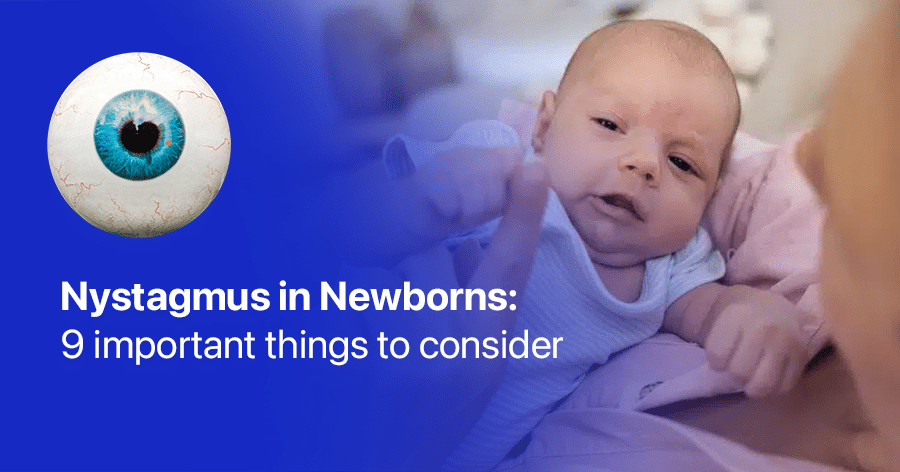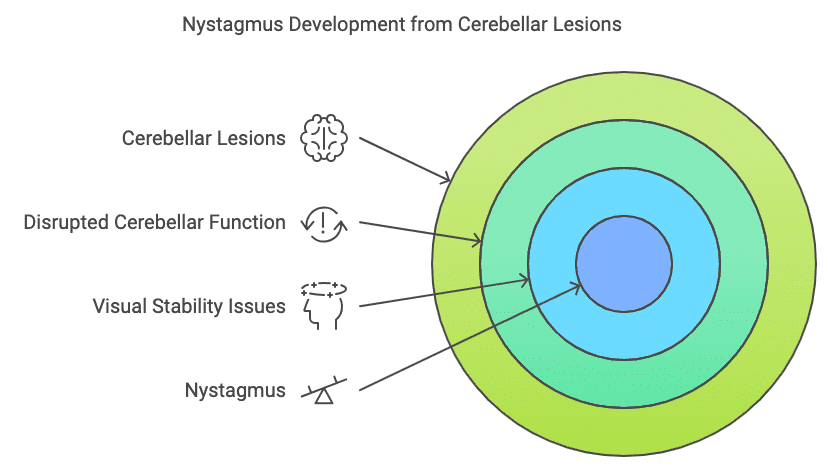
Nystagmus in Newborns: 9 important things to consider
As a neuro-ophthalmologist specializing in nystagmus, I’ve seen the worry in many parents’ eyes when they learn their newborn has been diagnosed with this condition. If you’re reading this, you’re probably feeling that same concern. But take heart! Understanding nystagmus in newborns is the first step to ensuring your little one gets the best care possible. Let’s dive into this topic together.
What is Nystagmus in Newborns?
Nystagmus in newborns, often called congenital nystagmus, is a condition where a baby’s eyes make repetitive, uncontrolled movements. These movements can be:
- Side to side (horizontal nystagmus)
- Up and down (vertical nystagmus)
- In a circular pattern (rotary nystagmus)
It’s important to note that while alarming, nystagmus itself isn’t painful for your baby.
How Common is Nystagmus in Newborns?
Nystagmus in newborns is relatively rare, affecting about 1 in 1,000 to 1 in 1,500 births. However, being rare doesn’t mean you’re alone in this journey!
Signs and Symptoms of Nystagmus in Newborns
Spotting nystagmus in a newborn can be tricky, but here are some signs to watch for:
- Repetitive eye movements, often more noticeable when your baby tries to focus
- Unusual head positions (they might tilt or turn their head to see better)
- Problems making eye contact
- Sensitivity to light
- Delayed visual development
Remember, babies’ vision develops rapidly in the first few months, so any concerns should be discussed with your pediatrician.
Causes of Nystagmus in Newborns
Nystagmus in newborns can have various causes:
- Idiopathic (unknown cause): Sometimes, we can’t pinpoint an exact reason.
- Genetic factors: Some forms of nystagmus run in families.
- Albinism: This condition affecting pigmentation often includes nystagmus.
- Congenital cataracts: Cloudiness in the eye’s lens can lead to nystagmus.
- Optic nerve issues: Problems with the nerve connecting the eye to the brain can cause nystagmus.
- Neurological conditions: Rarely, nystagmus can be a sign of a neurological issue.
Diagnosing Nystagmus in Newborns
If nystagmus is suspected in your newborn, here’s what you can expect:
- Comprehensive eye exam: We’ll look at your baby’s eye structures and movements.
- Family history: We’ll ask about any eye conditions in your family.
- Neurological exam: To rule out any brain-related causes.
- Genetic testing: In some cases, we might recommend genetic tests.
- Imaging studies: MRI or CT scans might be used to check for any structural issues.
Treatment Options for Nystagmus in Newborns
Treatment for nystagmus in newborns depends on the underlying cause. Options may include:
- Corrective lenses: Even for babies, glasses can sometimes help.
- Patching: Covering one eye can help in some cases.
- Medications: Rarely, certain medications might be prescribed.
- Surgery: In specific cases, eye muscle surgery might be recommended.
- Visual aids: As your child grows, various tools can help maximize their usable vision.
Remember, early intervention is key! The sooner we start managing nystagmus, the better the long-term outlook.
Living with Nystagmus: What to Expect as Your Baby Grows
While nystagmus is a lifelong condition, many children with nystagmus lead full, active lives. Here’s what you might expect:
- Visual acuity: Your child’s vision may be reduced, but rarely results in total blindness.
- Depth perception: They might have challenges judging distances.
- Education: Some children may need additional support in school.
- Sports and activities: Many children with nystagmus participate in various activities with some adaptations.
Supporting Your Baby with Nystagmus
As a parent, you play a crucial role in your baby’s development. Here are some tips:
- Create a visually stimulating environment: High-contrast toys and books can help visual development.
- Be patient: Your baby might need extra time to focus on objects or make eye contact.
- Follow medical advice: Regular check-ups and following treatment plans are crucial.
- Join support groups: Connecting with other parents can provide valuable insights and emotional support.
- Stay positive: Your attitude will greatly influence your child’s outlook on their condition.
When to Seek Immediate Medical Attention
While nystagmus itself isn’t an emergency, certain signs warrant immediate medical attention:
- Sudden onset of nystagmus in a previously unaffected baby
- Nystagmus accompanied by other neurological symptoms (seizures, loss of muscle tone)
- Any sudden change in your baby’s eye movements or vision
“The Nystagmus Book” Further Resources for Parents
As you navigate this journey with your newborn, having access to reliable, up-to-date information is crucial. For parents looking to deepen their understanding of nystagmus beyond what we’ve covered here, there are comprehensive resources available.
One such resource is “The Nystagmus Book,” a guide that compiles the latest research and management strategies for nystagmus as of 2024. In a field where information can quickly become outdated or misleading, having a science-based, reliable source is invaluable.
This book offers:
- The most recent research findings on nystagmus, including insights specific to infants and children
- Best practices for managing nystagmus throughout your child’s development
- Practical tips for daily life with a child who has nystagmus
- Explanations of the latest treatment options, helping you make informed decisions with your medical team
Whether you’re just beginning this journey with your newborn or looking to stay informed as your child grows, expanding your knowledge can help you feel more confident and empowered in supporting your child’s needs.
Conclusion: Hope for Babies with Nystagmus
A nystagmus diagnosis in your newborn can feel overwhelming, but remember: with proper care and support, most children with nystagmus thrive. As a parent, your love, patience, and advocacy are your baby’s greatest assets.
Stay informed, work closely with your medical team, and never hesitate to ask questions. Every child’s journey with nystagmus is unique, and with the right approach, your little one can look forward to a bright future.
Remember, you’re not alone in this journey. There’s a whole community of medical professionals, support groups, and other parents ready to support you and your baby every step of the way.




